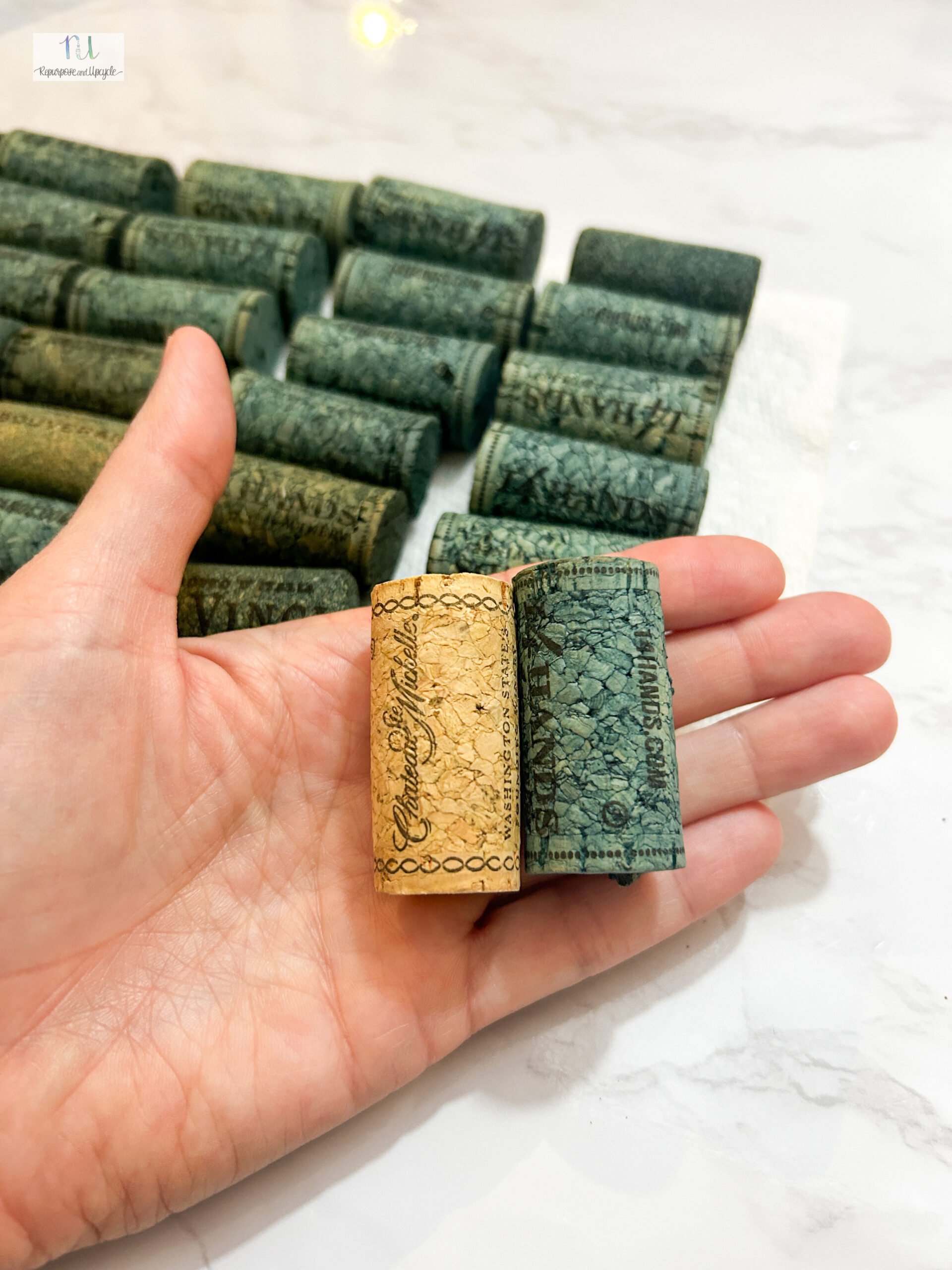There are a LOT of tutorials on how to paint laminate cabinets and laminate furniture. Does primer really matter? Do you need to sand? Well friends, I’m here to share my experiences with the RIGHT and the WRONG way to paint laminate cabinets, a laminate piece of furniture and even IKEA furniture (which is mostly a laminate surface). Take it from someone who has had success AND failure with this. I’m going to share the Do’s and the don’ts of painting laminate furniture.
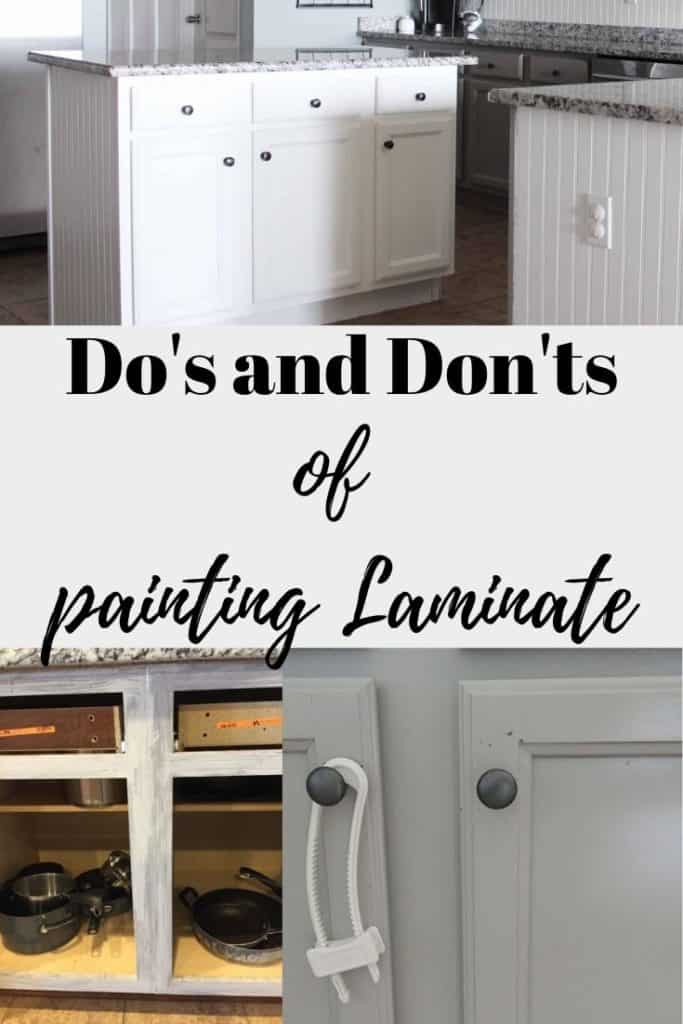
I mentioned that I’ve had success and failure with painting laminate surfaces. When I say I’ve had failure, that might be stretching it a little. My “failure” wasn’t really that bad, I just used a technique I wouldn’t use again. Before I get into that let’s discuss what laminate is made of.
What are laminate cabinets and laminate furniture made from?
Most laminate cabinets and laminate furniture are made from a pressed hard plastic, not real wood. Sometimes “laminate” cabinets are just that; a form of pressed board with a layer of thin laminate wood on top to give it a smooth finish. Either way we know one thing from this; they can’t be heavily sanded.
It’s virtually impossible to sand the “pressed hard plastic” type of laminate. Imagine trying to sand a plastic toy. Well, it might not be that extreme, but almost. This pressed hard plastic laminate was what my old laminate kitchen cabinets were made out of (talk about cheap cabinets). Needless to say I did not sand them before I began to paint. See more about how to paint laminate kitchen cabinets without sanding here.
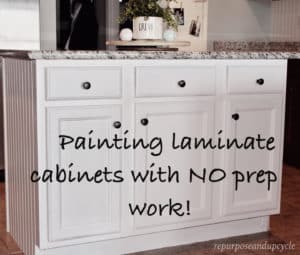
If you have the “thin layer of laminate wood” type of cabinets, my suggestions is to sand LIGHTLY with a 100 grit sand paper. Lightly is the key because you don’t want to sand through the thin surface.
If you are wondering about IKEA furniture, every piece is a little different. Most of the IKEA furniture I own seems to be made of the “pressed hard plastic” type. You can see more about how to paint IKEA furniture the RIGHT way here with a video tutorial.
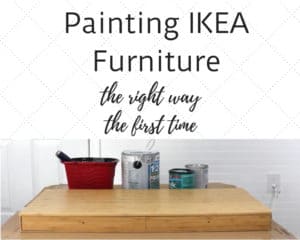
Disclosure; this post contains affiliate links. As an Amazon Associate I earn from qualifying purchases. This does not affect the price you pay. This disclosure statement refers to the rest of the Amazon links in this post. See more on my disclosure page.
The Do’s of painting on laminate furniture and cabinets
Do choose the right materials before beginning to paint laminate cabinets or furniture.
- Lint free cloths
- Painters tape
- Cleaner and degreaser
- Paint Sprayer
- Angled brushes or regular paint brush
- Foam brushes
- Fine finish paint rollers
- Primer
- Paint- my suggestion is to pick a good cabinet paint, milk paint or latex paint. I prefer water based.
- 120-grit Sandpaper if necessary
- Paint tray
Do Prepare the laminate surface before painting.
- Remove hardware and empty everything inside the cabinets or furniture.
- Use painters tape to tape around any areas you don’t want painted that can’t be removed.
- Apply a good cleaner or degreaser with a LINT FREE cloth to create a clean surface.
- Make sure the laminate surfaces are completely dry before painting.
Do use a good primer before even thinking of applying paint.
- Primer is KEY. This is where I went wrong when I painted my laminate cabinets the wrong way. Like I said earlier, most laminate surfaces are made of plastic and the only way to get paint to stick to plastic is with the right primer. I thought I could get away without creating a primed surface because the cabinet paint I used had a very good “bonding agent.” I’m not going to lie, it did very well (and still does), it just didn’t bond as well as it would have if I had primed first.
- In my opinion, the best bonding primer for laminate is a Zinsser primer. A lot of furniture painters will tell you to use a shellac based primer. Caution needs to be used when using shellac primers in a paint sprayer (which isn’t always recommended) due to the amount of alcohol fumes which also causes a fire risk. The bottom line, whether it’s an oil-based primer, water based primer or shellac primer, make sure it’s compatible with the surface and with the paint you will be using.
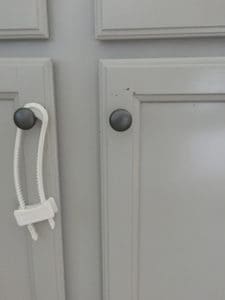
Do test the paint and primer first.
- Every piece of laminate furniture or surface is different. It’s always a good idea to “test” the paint and make sure it will bond and hold up to a lot of wear on the laminate surface.
- If you apply the first coat of paint (or primer) and it starts to “bubble,” this means it’s not adhering well. You can see where my first coat of cabinet paint (right below the countertops) bubbled. I should have known then that I needed to prime first to make the paint stick. Although it still turned out well, lesson learned.
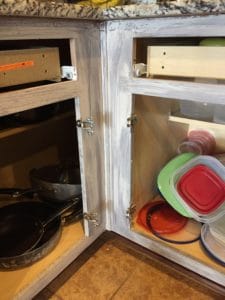
Do use a few coats of primer.
- Sometimes it takes more than one coat of primer to really cover the surface. My rule of thumb is normally two coats of primer and two coats of paint on a laminate surface. This is true for things like table tops, especially a laminate top.
Do pick a good quality paint.
- There are a few different options for what TYPE of paint to use when painting laminate. This isn’t a right or wrong answer.
- When I say “good quality” paint, I mean don’t go and buy the cheapest option. Buy a mid to high grade latex paint or a good milk paint. I would not suggest chalk paint as it does not hold up well to high traffic surfaces or heavy use. Big box stores make a “cabinet paint” which is what I used when I painted our kitchen cabinets. I also used General Finishes milk paint. They both worked well. When I painted the IKEA desk, I used a generic (but good quality) latex paint that has held up well. Rule of thumb is to always use a second coat of paint as well.
Do apply a good sealer.
- This step is almost as important as the primer.
- A good paint won’t last without a sealer.
- I’ve previously used a Polycrylic and high performance top coat. Both worked very well.
Do make sure to minimize brush strokes.
- The best way to avoid brush strokes and create a smooth surface is by using a paint sprayer. If this isn’t an option for you, you can use a good foam brush or fine finish roller for the last coat of paint. I’ve used both methods and they both work well.
- Sometimes using a sprayer isn’t an option for areas like the cabinet casings. In this case, you need to use a foam roller or brush.
- If you are covering a large surface area (like a lot of cabinets), it’s a good idea to invest in a paint sprayer.
Do watch out for dried paint drips.
- Make sure to inspect the entire piece after it’s been painted (while they are wet) to ensure you won’t have any dried paint drips.
- Remove paint drips with a foam brush painting in the direction that the surface has previously been painted.
The Don’ts of painting laminate Furniture
Don’t paint over damaged or chipping laminate.
- If you paint over an area that’s damaged or warped, it might not bond like the rest of the paint will.
- Make sure to repair the damage before you paint.
Don’t use an oil based paints when painting a laminate surface white.
- Oil based paints and sealers (like Polyurethane) tend to yellow over time.
- This is best avoided by using water based paints and sealers like Polycrylic.
Don’t skip the primer when updating laminate kitchen cabinets.
- If you only take one tip away from this post, consider this the one!
- Don’t skip the primer….enough said.
Learn from my mistakes below; I didn’t use primer and I didn’t empty the contents of my cabinets. You live and learn right?
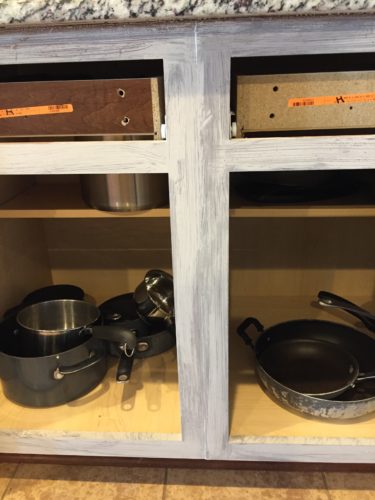
Don’t use old primer, old paint or old sealer to paint laminate cabinets.
- Sometimes we get busy and don’t want to hassle with buying new products. This is ok if your products are in good condition, but if your products are old, they won’t bond correctly and they won’t look smooth.
This is a picture of what happens when you use an old sealer.
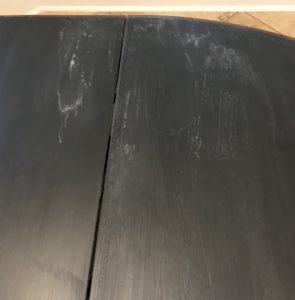
Do you see the white residue? I applied a layer of old Polycrylic to my moms chalk painted dining room table and almost ruined it! It turned out great, but not without a big furniture makeover mess up.
Do as I say not as I do, right? Want to learn more about furniture painting? I’ve got tons of painting tips and tricks that I wish I had known about years ago.
Well friends, I hope you’ve learned a few do’s and don’ts about how to paint laminate kitchen cabinets or laminate furniture.
Lindsey**


